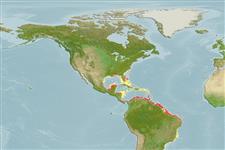| Native range | All suitable habitat | Point map | Year 2050 |

|
| This map was computer-generated and has not yet been reviewed. |
| Achirus achirus AquaMaps Data sources: GBIF OBIS |
Issue
The species Achirus lineatus Quoy & Gaimard, 1824 is cited as valid by Dennis et al. (2004: Ref. 51183) from Puerto Rico, followed by Eschmeyer (CofF ver. July 2013: Ref. 93826). However, a complete revision of the genus is necessary to sort out the difficulties. The distribution of A. achirus is referrred by Chabanaud (1928: 23) as "West coast of Americas, including West Indies. Cited from 7°N from 34°S.", and Cervigon (1966: 812) as "north and east of Gulf of Mexico to Rio Grande do Sul state, Brazil" (data on both papers are coincident). Cervigón (1996: 16) states: "its distribution extends from Golfo de Paria to Amazonas". No papers dealing with Achiridae include reference to a punctual collection of A. achirus in Gulf of Mexico or West Indies; Meek and Hildebrand (1928) do not cite this species to Panama. A. achirus was described from Suriname, and there are records from Venezuela, Suriname (the original description and other papers which refer to it), and Brazil (Figueirerdo & Menezes, 2000, Rosa, 1980). A. achirus securely do not occurs in southeastern South America (Figueirerdo & Menezes, 2000), the most south collection was taken at Paraíba state, northeastern Brazil (Rosa, 1980). The probable distribution of A. achirus is the coastal areas from Venezuela to northeastern Brazil, but it's necessary further studies to make a secure statement on distribution of this species. As several achirid species, it is a marine species which occasionally enters freshwaters; there is at least on record of this species for freshwater (Tocantins River at Cametá, Pará state, Brazil). Ortega and Vari (1986) cite A. achirus for freshwaters of Peru (Amazon basin), but it is a misidentification, as this species do not occurs in highland freshwaters. In this area occurs Hipoclinemus mentalis, which is frequently confounded with A. achirus.